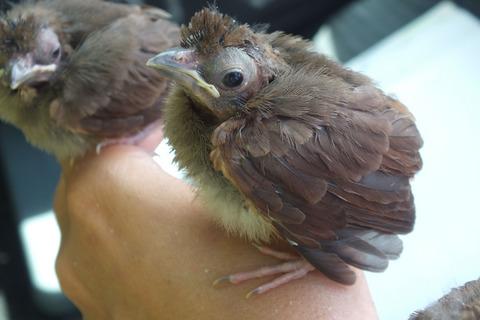当前位置:
X-MOL 学术
›
Funct. Ecol.
›
论文详情
Our official English website, www.x-mol.net, welcomes your
feedback! (Note: you will need to create a separate account there.)
Does the size and developmental stage of traits at fledging reflect juvenile flight ability among songbirds?
Functional Ecology ( IF 4.6 ) Pub Date : 2020-04-01 , DOI: 10.1111/1365-2435.13513 Todd M. Jones 1, 2 , Thomas J. Benson 1, 2 , Michael P. Ward 1, 2
Functional Ecology ( IF 4.6 ) Pub Date : 2020-04-01 , DOI: 10.1111/1365-2435.13513 Todd M. Jones 1, 2 , Thomas J. Benson 1, 2 , Michael P. Ward 1, 2
Affiliation

|
Morphological traits can influence the ability of animals to perform ecologically relevant tasks that are essential for their growth, survival and fitness. Understanding such links in juvenile animals is of particular importance, as periods of juvenile life are often associated with high rates of mortality and can be critical with respect to evolution of life histories and viability of populations. To study such links, an important first step is to assess relationships between juvenile morphologies and measures of performance. Altricial songbirds can provide novel insights into morphology–performance relationships owing to the high locomotor demand placed on juveniles after they leave the nest. Therefore, we examined the relationships between the size and developmental stage of juvenile traits and juvenile flight ability among 13 coexisting songbirds in east‐central Illinois. Among potential traits, we focused on relationships between flight ability and four measures of wing development at fledging as well as two body measures thought to reflect an individual's overall quality and musculature. Among measures of wing development, wing emergence was the strongest, most consistent predictor of ability within and among species. Relative wing length and wing emergence‐loading were often good predictors of flight ability as well, while relative wing‐loading was rarely a good predictor. Estimates of body mass and body condition were poor, inconsistent predictors of flight ability both within and among species. Our results highlight the importance of wing development for flight performance of juvenile songbirds. Furthermore, our evaluation of different wing characteristics suggests that the importance of macro‐scale transmissivity and wing/disc loading towards flight ability changes with respect to juvenile ontogeny. Though mass likely interacts with wing characteristics in determining flight ability, our results suggest that body mass and condition are likely reflective of other, non‐flight measures of fledgling performance. Few studies on altricial songbirds have examined morphology–performance relationships in juveniles. By linking wing emergence with juvenile flight ability, our research has taken a first step in assessing the adaptive significance of variation in wing development for juvenile songbirds. A free Plain Language Summary can be found within the Supporting Information of this article.
中文翻译:

雏鸟性状的大小和发育阶段是否反映了鸣禽的幼年飞行能力?
形态特征会影响动物执行生态相关任务的能力,这些任务对其生长、生存和健康至关重要。了解幼年动物中的这种联系特别重要,因为幼年期通常与高死亡率有关,并且对于生命史的进化和种群的生存能力至关重要。要研究这种联系,重要的第一步是评估幼鱼形态与性能指标之间的关系。由于幼鸟离开巢穴后对运动能力的要求很高,因此老年鸣禽可以提供对形态-表现关系的新见解。所以,我们研究了伊利诺伊州中东部 13 只共存鸣禽的幼鸟特征的大小和发育阶段与幼鸟飞行能力之间的关系。在潜在的特征中,我们专注于飞行能力与羽翼发育的四个指标以及被认为反映个人整体素质和肌肉组织的两个身体指标之间的关系。在翅膀发育的测量中,翅膀的出现是物种内部和物种之间能力的最强、最一致的预测指标。相对机翼长度和机翼出现载荷通常也是飞行能力的良好预测因子,而相对翼载荷很少是一个很好的预测因子。对体重和身体状况的估计很差,物种内部和物种之间的飞行能力预测指标不一致。我们的结果强调了翅膀发育对幼鸟飞行性能的重要性。此外,我们对不同机翼特性的评估表明,宏观透射率和机翼/盘负载对飞行能力的重要性在幼虫个体发育方面发生了变化。尽管在确定飞行能力时质量可能与机翼特征相互作用,但我们的研究结果表明,体重和状况可能反映了其他非飞行指标的雏鸟性能。很少有关于候鸟鸣禽的研究检查了幼鸟的形态-表现关系。通过将翅膀出现与幼鸟的飞行能力联系起来,我们的研究在评估幼鸟翅膀发育变异的适应性意义方面迈出了第一步。
更新日期:2020-04-01
中文翻译:

雏鸟性状的大小和发育阶段是否反映了鸣禽的幼年飞行能力?
形态特征会影响动物执行生态相关任务的能力,这些任务对其生长、生存和健康至关重要。了解幼年动物中的这种联系特别重要,因为幼年期通常与高死亡率有关,并且对于生命史的进化和种群的生存能力至关重要。要研究这种联系,重要的第一步是评估幼鱼形态与性能指标之间的关系。由于幼鸟离开巢穴后对运动能力的要求很高,因此老年鸣禽可以提供对形态-表现关系的新见解。所以,我们研究了伊利诺伊州中东部 13 只共存鸣禽的幼鸟特征的大小和发育阶段与幼鸟飞行能力之间的关系。在潜在的特征中,我们专注于飞行能力与羽翼发育的四个指标以及被认为反映个人整体素质和肌肉组织的两个身体指标之间的关系。在翅膀发育的测量中,翅膀的出现是物种内部和物种之间能力的最强、最一致的预测指标。相对机翼长度和机翼出现载荷通常也是飞行能力的良好预测因子,而相对翼载荷很少是一个很好的预测因子。对体重和身体状况的估计很差,物种内部和物种之间的飞行能力预测指标不一致。我们的结果强调了翅膀发育对幼鸟飞行性能的重要性。此外,我们对不同机翼特性的评估表明,宏观透射率和机翼/盘负载对飞行能力的重要性在幼虫个体发育方面发生了变化。尽管在确定飞行能力时质量可能与机翼特征相互作用,但我们的研究结果表明,体重和状况可能反映了其他非飞行指标的雏鸟性能。很少有关于候鸟鸣禽的研究检查了幼鸟的形态-表现关系。通过将翅膀出现与幼鸟的飞行能力联系起来,我们的研究在评估幼鸟翅膀发育变异的适应性意义方面迈出了第一步。











































 京公网安备 11010802027423号
京公网安备 11010802027423号